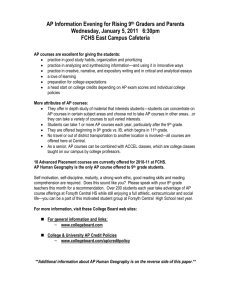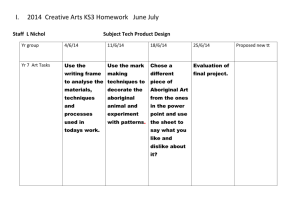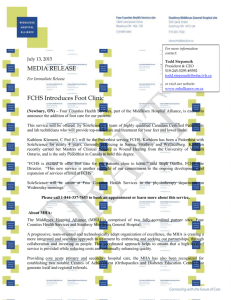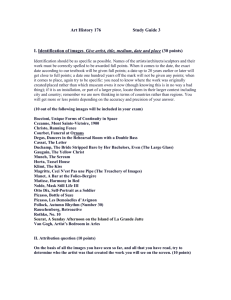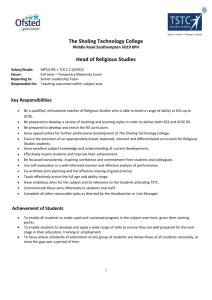File - FCHS ART DEPARTMENT
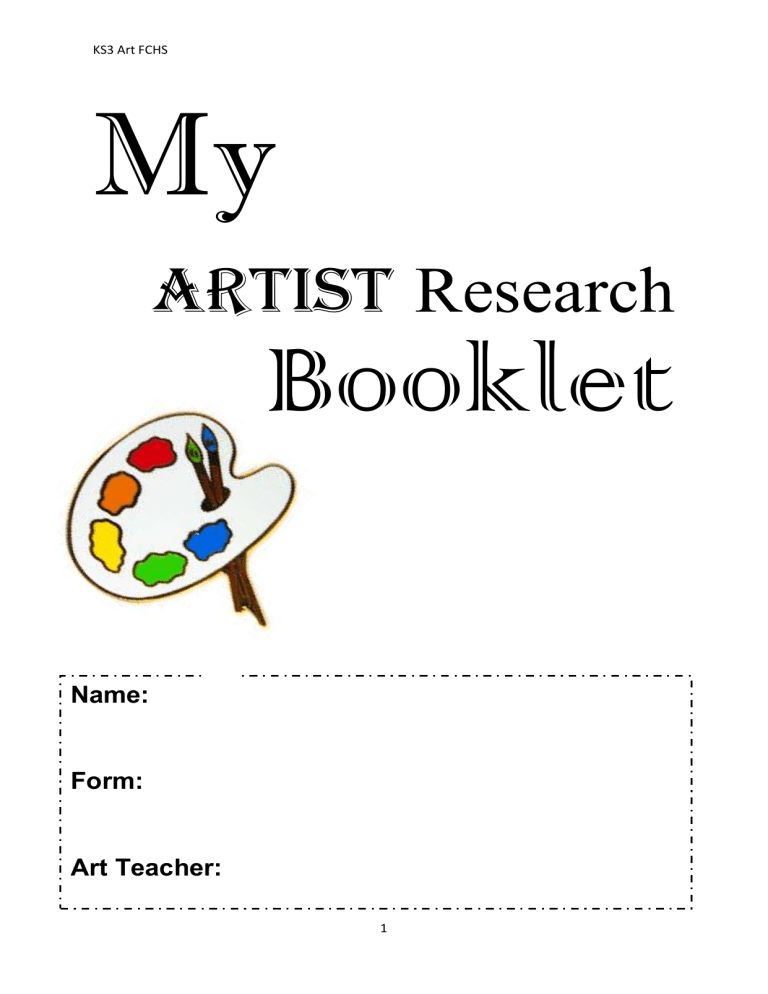
KS3 Art FCHS
My
Artist
Research
Booklet
Name:
Form:
Art Teacher:
1
KS3 Art FCHS
Pablo Picasso
Pablo Picasso was born in Málaga, Spain. When he was baptized, he was named after various saints and relatives: Pablo Diego José Francisco de Paula Juan Nepom uceno María de los
Remedios Cipriano de la Santísima Trinidad Martyr Patricio Clito Ruíz y Picasso. His father,
Jose Ruiz Blasco, was an artist and art professor who gave Pablo art lessons. His mother was
Maria Picasso y Lopez. According to his mother, his first word was “piz” when he was trying to say “lápiz,” the Spanish word for pencil.
Picasso was not a good student. He often had to go to detention. Here’s what he said about it.
“For being a bad student I was banished to the ‘calaboose’ – a bare cell with whitewashed walls and a bench to sit on. I liked it there, because I took along a sketch pad and drew incessantly … I could have stayed there forever drawing without stopping ”
Does she look:
Happy
Sad
Frightened
Angry ?
Task: Using line only and basic shapes such as squares, rectangles, circles, ovals and triangles draw a different face in each of the boxes in the grid.
(One has already been filled in for you)
Task: How many of these geometric shapes can you draw?
Pentagon Hexagon Octagon Decagon
2
KS3 Art FCHS
In 1900, Picasso went to Paris. He met Max Jacob, a journalist and poet. Max helped Picasso learn to speak French. He also met many of the famous artists who lived in Paris. In 1905,
American art collectors Leo and Gertrude Stein began to collect his work and helped to make him famous.
He and Georges Braque invented Cubism, a form of painting that featured simple geometric shapes. He is also known for making collages – gluing previously unrelated things together with images. He created oil paintings, sculpture, drawings, stage designs, tapestries, rugs, etchings, collage, and architecture. No other painter or sculptor was as famous while he was still alive. It is estimated that Picasso produced at least 50,000 works of art: 1,885 paintings;
1,228 sculptures; 2,880 ceramics, roughly 12,000 drawings, many thousands of prints, and numerous tapestries and rugs. He also wrote plays and poetry. He became very wealthy.
Picasso quotes:
“I paint objects as I think them, not as I see them. ”
“All children are artists.
The problem is how to remain an artist once he grows up. ”
“Action is the foundational key to all success.”
Task: Complete a detailed copy of Picassos painting above in the box provided. Add colour
3
KS3 Art FCHS vocabulary .
Exaggerate represent
Distort pull or twist out of
Medium – Materials used e.g.
FORM:
What is the medium of the work?
What colours does the artist use?
What kind of shapes or objects/people can you find?
What kind of marks or techniques does the artist use?
MOOD:
How does the work make you feel?
What is in the image that affects you?
4
Has the artist managed to challenge you in any way?
KS3 Art FCHS
5
Task: Roll the dice and using the features your number lands on create a Picasso style portrait in the face outline below!
When complete add colour.
KS3 Art FCHS
Vincent Van Gogh
Where did Vincent van Gogh grow up?
Vincent van Gogh was born in the Netherlands in 1853. His father and grandfather were ministers, but others in his family worked in the art world. Vincent had two brothers and three sisters. He was closest to his younger brother Theo.
Years in Paris
During this time Van Gogh began to use brighter colours. His brushwork also became more broken. He painted subjects from the streets and cafes of Paris as well as the countryside. Van Gogh also became interested in painting portraits of people.
When he couldn't find models, he would paint himself for practice. He painted over twenty self portraits during this time.
Task: What do you like about this painting and why?
Mental Hospital
In 1889 Van Gogh committed himself to a mental hospital. He could barely take care of himself. He still continued to paint and painted one of his most famous paintings Starry
Night . Many of his paintings during this time featured cypress trees and lots of swirling colours. Van Gogh's mental state continued to deteriorate. On July 29, 1890 he died from a self-inflicted bullet wound to the chest.
Task: Colour in the copy of Starry Night provided using your own colour scheme. Remember to add tone and movement through your colouring skills.
6
KS3 Art FCHS
Did he really cut off his ear?
Yes. After an argument with painter Paul Gauguin, van Gogh went home and cut off part of his left ear with a razor blade. He then wrapped up the ear in a cloth and presented it to a woman as a "present".
Task:
Complete the self portrait of
Vincent Van
Gogh by replacing his face with your own. Using a mirror add as much detail as you can and when you have finished add colour.
Interesting Facts about Vincent Van Gogh
He would get so obsessed with painting that he often wouldn't eat. He had poor health
as a result.
Van Gogh was influenced by Japanese prints and woodcuts which he studied
intensely.
Some people think that he may have only sold one work during his lifetime. It was called The Red Vineyard .
His brother Theo died six months after Vincent and was buried next to him.
In some of his self portraits his ear is bandaged from when he cut it. It looks like his
right ear in the pictures because he was using a mirror to paint himself.
You can see the painting Starry Night at the New York Museum of Modern Art.
7
KS3 Art FCHS
Vincent Van Gogh Word Search !
Task: Find these words!
Arles, Artist, Earless, Epilepsy, Expressionism, France, Homeschooled, Iris, Landscapes, Lemons,
Missionary, Oil Paints, Painter, Peasants, Post-Impressionist, Potato Eaters, Razor, Starry Night,
Starrynight, Still Life, Sunflowers, Theo, Thepotatoeaters, Van Gogh, Vincent, Vincentvangogh,
Yellow House
8
KS3 Art FCHS
Task: Answer the questions below about the image in the center of the page in the spaces provided under the question. Use full sentences and correct vocabulary .
KEY WORDS: CONTENT:
Exaggerate represent something as being larger, better, or worse than it really is.
What is happening in the image?
Distort pull or twist out of shape
Is it a true representation or has it been exaggerated or distorted?
Medium – Materials used e.g. paint, pen, biro, photograph, post it notes.
FORM:
What is the medium of the work?
What do you think the story behind the image is about?
What colours does the artist use?
What kind of shapes or objects/people can you find?
What kind of marks or techniques does the artist use?
MOOD:
How does the work make you feel?
What is in the image that affects you?
9
Has the artist managed to challenge you in any way?
KS3 Art FCHS
Antoni Gaudi
Gaudi was born in Spain in 1852. He studied architecture in Barcelona, Spain at the
Escola Tecnica Superior d’Arquitectura but he was not a very good student. After five years, in 1878, Gaudi officially became an architect.
He began designing small projects but soon met Eusebi Guell. Guell became
Gaudi’s patron and the architect designed buildings and parks in his name. You saw a picture of Parque Guell yesterday. Go click through the photos at the main Palau
Guell website. I especially like the chimneys that grow atop the building like colorful trees.
Task: Complete a copy of Gaudi’s mosaic lizard in the box provided. Fill the box and add detail. Once you have copied the lizard add colour with felt tips !
Task: Using the mosaic pattern provided draw a sea creature of your choice and colour in !
10
KS3 Art FCHS
You can see the characteristics of Art Nouveau in Gaudi’s work. There are bright tile mosaics and curving lines. He was very influenced by nature as you can see in the chimneys at Palau Guell.
Task: Design two chimney tops that look like Gaudi’s !
The building that Antoni Gaudi is best known for, though, is La Sagrada Familia in
Barcelona (shown below). He began this huge church in 1882 and he worked on it until he died in 1926. It still has not been finished. Gaudi designed and redesigned this building. He was forever tinkering with the plans. Unfortunately, the last blueprint he drew was destroyed in 1938 so the architects who are currently working on the building don’t know exactly what Gaudi had in mind for the church.
Task: Using the ‘La
Sagrada Familia’ as inspiration design your own church with an ocean theme. Remember to add details and colour.
11
KS3 Art FCHS
Task: Answer the questions below about the image in the center of the page in the spaces provided under the question. Use full sentences and correct vocabulary .
KEY WORDS:
Exaggerate represent
CONTENT:
What is happening in the image? something as being larger, better, or worse than it really is.
Distort pull or twist out of shape
Medium – Materials used e.g. paint, pen, biro, photograph, post it notes.
FORM:
What is the medium of the work?
Is it a true representation or has it been exaggerated or distorted?
What do you think the story behind the image is about?
What colours does the artist use?
MOOD:
What kind of shapes or objects/people can you find?
How does the work make you feel?
What is in the image that affects you?
What kind of marks or techniques does the artist use?
12
Has the artist managed to challenge you in any way?
KS3 Art FCHS
Andy Warhol
Where did Andy Warhol grow up?
Andy grew up in Pittsburgh, Pennsylvania the son of a construction worker. His birth name was
Andrew Warhola. When he was 8 years old he caught a liver disease that caused his limbs to sometimes spasm uncontrollably. While recovering his mother, an embroiderer and artist, taught him to draw. He was a quiet and shy child, but loved drawing, photography, and movies.
When Andy was fourteen, his father died from liver disease. His father considered Andy the brightest of his children and had saved money for Andy to go to college. When he graduated from high school, he went to Carnegie Mellon University to study art.
Pop Art
In 1961 Andy came up with the concept of using mass-produced commercial goods in his art. He called it Pop Art. He would use commercial images and reproduce them over and over. One early example of this was a series on Campbell's Soup cans. In one painting he had two hundred
Campbell's soup cans repeated over and over. Andy often used silkscreen and lithography to create his pictures.
Task: Choose your favourite fizzy drink logo and draw the design on the can provided. Colour in using bright pop art style colours like Andy
Warhol.
Famous People
13
KS3 Art FCHS
Andy also used pictures of famous people. He would repeat the same portrait over and over, but use different colours and effects in each picture. Some of the celebrities he had as subjects include
Marilyn Monroe, Che Guevara, Mao Zedong, and Elizabeth Taylor.
Task: Copy the image of Batman into the remaining 3 squares and colour each one using a variety of bright colours similar to Warhol’s ‘Marilyn Monroe’.
14
KS3 Art FCHS
Legacy
Andy was a different kind of artist. While many artists focused entirely on their art with no interest in personal fame or fortune, Andy wanted to be rich and famous. Some artists accused him of making art in order to make money. However, many of the images he created have become iconic in
American culture. His paintings have grown in value as well. One of his portraits called Eight Elvises sold for $100 million in 2008.
Despite having made a lot of money off of his art, Andy can also be credited with bringing art to the masses. He would mass produce prints of his art so it was affordable to everyone.
Interesting Facts about Andy Warhol:
His birth date was never recorded at a hospital. Andy liked to change his birthday and make up stories about his youth when doing interviews with the press.
He once said that "good business is the best art."
He was also interested in film and music.
He produced around 60 films and supported a band called the Velvet
Underground. One of his movies was a 6 hour film of his friend sleeping called
Sleep .
Andy was shot three times in the chest
by feminist Valerie Solanis and nearly died on June 3, 1968.
He died in the hospital after surgery on his gall bladder.
His parents were immigrants from
Slovakia.
15
Task: Answer these questions about the ‘Eight Elvises’
What is the medium of the work?
What colours does the artist use?
What is happening in the image?
Is it a true representation or has it been exaggerated or distorted?
Does the subject have any obvious or hidden meanings?
What do you think the story behind the image is about?
How does the work make you feel?
KS3 Art FCHS
Michael Craig Martin
Michael Craig-Martin was born in Dublin Ireland in 1941. He grew up and was educated in the United States, studying Fine Art at the Yale University School of Art. He came to Britain on completion of his studies in 1966, and has lived and worked there ever since.
His first solo exhibition was at the Rowan Gallery, London in 1969. He participated in the definitive exhibition of British conceptual art, “The New Art” at the Hayward Gallery in
1972. Throughout his career, through work in many different media, he has explored the expressive potential of commonplace objects and images. His best known works include An oak tree of 1973, in which he claimed to have changed a glass of water into an oak tree; his large-scale black and white wall drawings; and his intensely coloured paintings, installations, and public commissions.
An Oak Tree consists of an ordinary glass of water placed on a small glass shelf of the type normally found in a bathroom, which is attached to the wall above head height. Craig-
Martin composed a series of questions and answers to accompany the objects. In these, the artist claims that the glass of water has been transformed into an oak tree.
Task: Create a drawing of an object on a shelf and give the art work a title like ‘An Oak Tree’.
Explain briefly why you have chosen the object and how it relates to the title given.
16
KS3 Art FCHS
Task: Answer the questions below about the image in the center of the page in the spaces provided under the question. Use full sentences and correct vocabulary .
KEY WORDS: CONTENT:
Exaggerate represent something as being larger, better, or worse than it really is.
Distort pull or twist out of shape
What is happening in the image?
Is it a true representation or has it been exaggerated or distorted?
Medium – Materials used e.g. paint, pen, biro, photograph, post it notes.
FORM:
What is the medium of the work?
What colours does the artist use?
What kind of shapes or objects/people can you find?
What kind of marks or techniques does the artist use?
What do you think the story behind the image is about?
MOOD:
How does the work make you feel?
What is in the image that affects you?
17
Has the artist managed to challenge you in any way?
KS3 Art FCHS
Craig-Martin is well known to have been an influential teacher at the Goldsmiths College
London, and is considered a key figure in the emergence of the young British artists in the early 90′s. Amongst his former students are Ian Davenport, Damien Hirst, Gary Hume, Liam
Gillick, Sarah Lucas, Julian Opie, and Fiona Rae.
Task: Produce a copy of the above Michael
Craig Martin image.
Remember to add all the objects and colour in matching the colours as closely as you can.
18
KS3 Art FCHS
Task: Choose an object from around the classroom and produce an observational drawing in the style of Craig Martin. Only draw the outline of the object to fill the space provided and then colour in using bright colours with no tone or shading. Look at examples above!
19
KS3 Art FCHS
Albrecht Durer
German Renaissance artist Albrecht Durer was born May 21, 1471, in
Nurnberg. In 1494 he travelled to Italy, where he remained until 1495. The trip had a strong effect on Durer; echoes of Italian art are apparent in most of his drawings, paintings, and graphics of the following decade. Italian influences were slower to take hold in his graphics than in his drawings and paintings. He died in 1528.
This print of a rhinoceros was created by Albrecht Dürer, the most famous artist of his day. Dürer's celebrity was in part due to his ability to make his work both available and affordable to a mass audience. The new technology of woodcut printing allowed drawings to be mass produced; around 4000 to 5000 copies of the rhino print were probably sold in Dürer's lifetime.
Dürer, however, never actually saw a live rhino and based his drawing on a brief sketch and a letter.
20
KS3 Art FCHS
21
KS3 Art FCHS
Task: Answer the questions below about the image in the center of the page in the spaces provided under the question. Use full sentences and correct vocabulary .
KEY WORDS:
Exaggerate represent something as being larger, better, or worse than it really is.
Distort pull or twist out of shape
Medium – Materials used e.g. paint, pen, biro, photograph, post it notes.
FORM:
What is the medium of the work?
What colours does the artist use?
What kind of shapes or objects/people can you find?
What kind of marks or techniques does the artist use?
CONTENT:
What is happening in the image?
Is it a true representation or has it been exaggerated or distorted?
What do you think the story behind the image is about?
MOOD:
How does the work make you feel?
What is in the image that affects you?
22
Has the artist managed to challenge you in any way?
KS3 Art FCHS
Task: Using the variety of mark making techniques you have used in the grid on the previous page fill in Durer’s rhinoceros. Remember to fill in all the gaps and add shading where needed.
23
KS3 Art FCHS
Chris Ofili
Chris Ofili is an English painter, who studied in London at Chelsea School of Art (1988-91) and the Royal College of Art (1991-3). In 1992 Chris Ofili was awarded a travelling scholarship to Zimbabwe, an experience that profoundly influenced his approach to painting, using references from African music, culture, religion and textiles, he began to experiment with unconventional techniques, materials (famously elephant dung) and subject matter. Chris Ofili's works are vibrant, technically complex and meticulously executed, consisting of layers of paint, resin, glitter and collage. Using heavily decorative and intricate patterns he explores widely diverse themes, including sacred ideals, identity, black history, high and low culture and self-awareness.
O nce upon a time
Task: In the space provided write a short fantasy story describing the events that could have lead up to this painting being produced … e.g. who is the woman ? why is she sad ?
24
KS3 Art FCHS
Task: Using Ofilis painting ‘No woman no cry’ create a portrait of your own profile using a mirror, pencil and water paint. Remember to fill in the whole space provided below.
25
KS3 Art FCHS
Task: Answer the questions below about the image in the center of the page in the spaces provided under the question. Use full sentences and correct vocabulary .
KEY WORDS: CONTENT:
Exaggerate represent something as being larger, better, or worse than it really is.
Distort pull or twist out of shape
Medium – Materials used e.g. paint, pen, biro, photograph, post it notes.
FORM:
What is the medium of the work?
What is happening in the image?
Is it a true representation or has it been exaggerated or distorted?
What do you think the story behind the image is about?
What colours does the artist use?
What kind of shapes or objects/people can you find?
What kind of marks or techniques does the artist use?
MOOD:
How does the work make you feel?
What is in the image that affects you?
26
Has the artist managed to challenge you in any way?
KS3 Art FCHS
Studio Ghibli, Inc
is a Japanese animation film studio based in
Koganei, Tokyo, Japan.
The studio is best known for its anime feature films, and has also produced several short films, television commercials, and one television film. It was founded in June 1985 after the success of
Nausicaä of the Valley of the Wind
(1984), with funding by Tokuma
Shoten.
Eight of Studio Ghibli's films are among the 15 highest-grossing anime films made in Japan, with
Spirited Away
(2001) being the highest, grossing over $274 million worldwide. Many of their works have won the Animage Anime Grand Prix award, and four have won the Japan Academy Prize for Animation of the Year. In 2002,
Spirited
Away
won a Golden Bear and an Academy Award for Best Animated
Feature Film.
On August 3, 2014, Studio Ghibli announced it was temporarily halting production following the retirement of director Hayao
Miyazaki
27
KS3 Art FCHS
Task: In the space provided follow the step by step instructions to draw an anime face. Add your own hair and style to make yours unique.
28
KS3 Art FCHS
Fun Fact :
In the English dub of "Howl's Moving Castle", the lead character, Howl, was voiced by Christian Bale, who also starred as Batman in "Batman Begins" (2005) and "The Dark
Knight" (2008).
29
KS3 Art FCHS
Task: Using the studio Ghibli creatures as inspiration create your own fantasy creature to go in the forest provided.
Complete image by colouring in.
30
KS3 Art FCHS
Task: Using the above examples create a short animation flip book of 8 pages to create a story.
Remember to add detail, action and colour. * Your story could be about the creature you created on the previous page !
THE END !
Have a nice summer !!
31
